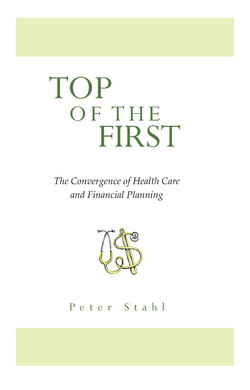Читать книгу Top of the First 2016 - Peter Stahl - Страница 1
Introduction
Оглавление“It's getting late early” —Yogi Berra
The task of planning and preparing for your retirement years has many components. One of these components, health care, has risen to the forefront of major issues facing our nation. As I speak to individuals and financial advisors about the impact of health care costs on their retirement income plans, it is obvious that most people are just beginning to recognize the need to incorporate health care planning into their financial planning. As they say in baseball, we are in the top of the first inning. Common wisdom encourages us to begin any financial planning process early allowing time for the plan to work. In this respect, the top of the first inning is a good place to be. The challenge we face as a nation is that the front edge of the largest segment of the U.S. population is already entering their retirement years. As Yogi Berra might say, "It's getting late early."
There is an abundance of information available regarding how to effectively save and invest your money in order to build a source of income for that period of time following your chosen career. This involves decisions such as the type of investment products you should own and optimal allocations within equity, fixed income, domestic, international, growth, and value. These are critical decisions but most of the planning process, until recently, has failed to incorporate the impact of health care costs. Those heading into retirement have communicated that these costs represent one of their largest concerns. This is quite understandable.
The age 50+ population ranks health care expenses as their top financial concern for retirement.1
This same group states that the information needed to determine health care costs is overwhelming, confusing, and frustrating.1
I do not wish to bombard the reader with statistics, but rather to point out that the concerns are justified. Simply put, Americans are living much longer lives in a country that enjoys some of the finest medical care available anywhere in the world. This care is expensive. Diligent planning and saving for these expenditures need to take place. Most of the popular media describes how Americans are not financially prepared for retirement. There are, however, at least some encouraging trends.
45% of workers age 50-64 (peak retirement savings years) are saving specifically for health care costs. This percentage has doubled over the last six years.2
Recognizing the need to plan for this cost is a solid start, but exactly how you choose to plan and invest for these expenditures will determine how effective these investments will be in funding your health care expenditures.
The purpose of this book is to provide those who are saving and investing for retirement, as well as those already in retirement, strategies to ensure that your investment planning incorporates the optimal strategies to provide for health care expenses. Medicare, the mandatory means most Americans will utilize for retirement health care insurance, will play a major role in this discussion. Medicare costs and the taxation of Medicare premiums have a direct impact on retirement income. There are tangible, immediate steps you can take to make sure you are financially prepared.
Proper financial planning contributes to peace of mind. Given the enormity of health care costs, these strategies have a meaningful impact on your ability to create efficient sources of retirement income, meet your health care expenses, and feel secure in your retirement.
Once again, the focus is on the convergence of financial planning and health care costs. Although I will provide an overview of various elements of your health care coverage, this book is not a resource manual for the details of Medicare, Medigap polices, or custodial care. Speaking to the convergence of financial planning with health care, the content is naturally most beneficial to those who are investing for retirement or those who are in retirement, having accumulated some level of wealth to provide for their expenses. In fact, higher levels of assets usually equate to higher taxation and Medicare premiums. The more diligent you are with investing, the greater the benefit these strategies will be.
Certain biases will become evident as you read this material. The most obvious one I will state up front. You will find multiple references to financial advisors and the need to work with your advisor to implement the strategies described in this book. Comprehensive financial planning is complex, especially when including the nuances of health care costs and taxation. I believe that consolidating financial assets with a competent financial advisor, who will consult with your tax professional, is the most prudent way to tackle the task. There are those who have the interest, time, and knowledge to create and maintain these plans on their own, but in my experience they represent a distinct minority.
My hope is that you will adopt these ideas early on as you invest and plan for retirement.
